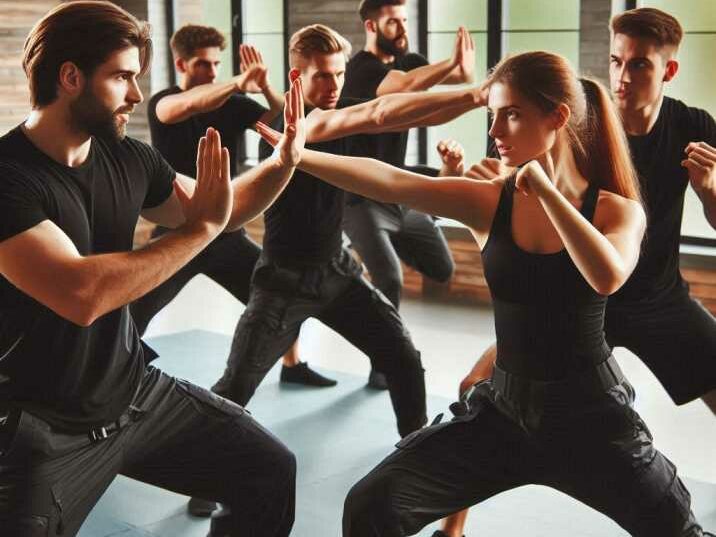Introduction
Table of Contents
Are you ready to take control of your personal safety and build confidence in high-stress situations? Welcome to the world of Krav Maga! This self-defense system, originally developed for the Israeli military, has become a popular choice for people seeking an effective way to protect themselves. In this comprehensive guide, we’ll walk you through everything you need to know about Krav Maga for beginners—from its history and principles to practical techniques you can start practicing today.

What is Krav Maga?
A Brief History
Krav Maga, which means “contact combat” in Hebrew, was created by Imi Lichtenfeld in the 1930s. Initially developed for the Israeli Defense Forces (IDF), it combines techniques from boxing, wrestling, judo, and other martial arts. Its primary aim is to provide practical self-defense skills that can be used in real-world situations.
Core Principles
Krav Maga is designed around a few key principles:
- Neutralizing Threats Quickly: The goal is to end a confrontation as quickly as possible.
- Defending and Attacking Simultaneously: This principle allows you to protect yourself while incapacitating your attacker.
- Using Natural Reflexes: Techniques are based on the body’s natural reactions to threats, making them easier to learn and execute under stress.
- Targeting Vulnerable Areas: Krav Maga teaches you to strike parts of the body that are most sensitive, like the eyes, throat, and groin.
Benefits of Learning Krav Maga for Beginners
Physical Fitness
Krav Maga is a full-body workout that improves strength, endurance, and flexibility. Regular training can help you lose weight, build muscle, and increase your overall fitness level.
Mental Toughness
Training in Krav Maga helps build mental resilience and the ability to remain calm under pressure. This mental toughness can translate into other areas of your life, making you more confident and assertive.
Practical Self-Defense
Unlike traditional martial arts, Krav Maga focuses on real-world scenarios. You’ll learn how to defend yourself in various situations, from street attacks to home invasions, making it an invaluable skill set for personal safety.
Community and Camaraderie
Joining a Krav Maga class introduces you to a community of like-minded individuals. The camaraderie and support can make your training experience more enjoyable and motivating.
Getting Started with Krav Maga for Beginners
Finding the Right School
When looking for a Krav Maga school, consider the following factors:
- Certified Instructors: Ensure the instructors are certified by a reputable organization.
- Class Structure: Look for schools that offer beginner classes and have a clear curriculum.
- Facilities: Check the quality of the training facilities, including mats and safety equipment.
- Trial Classes: Many schools offer trial classes—take advantage of these to find the best fit for you.
Essential Gear
To get started, you’ll need some basic gear:
- Comfortable Workout Clothes: Wear clothes that allow you to move freely.
- Protective Gear: Mouthguards, groin protectors, and shin guards are recommended.
- Training Shoes: Opt for lightweight, non-slip shoes.
Basic Techniques of Krav Maga for Beginners
Here are some fundamental techniques you’ll learn in a beginner’s Krav Maga class:
- Stance and Movement: Learn the basic fighting stance and how to move efficiently.
- Strikes: Master basic strikes like punches, elbow strikes, and knee strikes.
- Defensive Moves: Practice defenses against common attacks like chokes, grabs, and punches.
- Ground Fighting: Get comfortable defending yourself on the ground.
Practical Tips of Krav Maga for Beginners
Consistency is Key
Like any skill, the more consistently you practice, the better you’ll become. Aim to attend classes regularly and practice techniques at home.
Focus on Form
Proper form is crucial for both effectiveness and safety. Pay attention to your instructor’s guidance and don’t rush through techniques.
Stay Relaxed
Tension can slow you down and make you less effective. Practice relaxation techniques and stay calm during training.
Listen to Your Body
Krav Maga is physically demanding. It’s important to listen to your body and rest when needed to avoid injuries.
Advanced Techniques and Progression
From Basics to Advanced
Once you’ve mastered the basics, you’ll move on to more advanced techniques, such as:
- Weapon Defenses: Learn how to defend against knives, guns, and other weapons.
- Multiple Attackers: Practice strategies for dealing with multiple assailants.
- Advanced Strikes and Kicks: Refine your striking techniques and incorporate more complex kicks.
Ranking System
Krav Maga schools often have a ranking system similar to martial arts belts. Progressing through the ranks involves passing tests that demonstrate your proficiency in various techniques.
Integrating Krav Maga into Daily Life
Awareness and Prevention
Krav Maga is not just about physical techniques—it also emphasizes awareness and prevention. Stay alert to your surroundings and avoid risky situations whenever possible.
Conflict De-escalation
Learning how to de-escalate conflicts verbally is an essential part of Krav Maga training. Sometimes, the best defense is avoiding a physical confrontation altogether.
Fitness and Health
The physical conditioning you gain from Krav Maga will enhance your overall health and well-being. Make fitness a priority in your daily life.
Table Summarizing the Key Information about Krav Maga for Beginners:
| Category | Details |
|---|---|
| Introduction | Effective self-defense system, developed for Israeli military, boosts personal safety. |
| History | Created by Imi Lichtenfeld in the 1930s for the Israeli Defense Forces (IDF). |
| Core Principles | Neutralize threats quickly, defend and attack simultaneously, use natural reflexes, target vulnerable areas. |
| Benefits | Improves physical fitness, builds mental toughness, practical self-defense, community support. |
| Getting Started | Find certified instructors, take trial classes, wear comfortable clothes and protective gear. |
| Basic Techniques | Learn stance, movement, strikes, defensive moves, and ground fighting. |
| Advanced Progress | Weapon defenses, strategies for multiple attackers, advanced strikes and kicks. |
| Daily Integration | Emphasize awareness, conflict de-escalation, maintain fitness and health. |
Conclusion
Krav Maga for Beginners, Krav Maga offers a comprehensive approach to self-defense that’s practical, effective, and empowering. From improving your physical fitness to boosting your mental resilience, the benefits are vast. Whether you’re looking to protect yourself or simply seeking a new way to stay fit, Krav Maga has something to offer.
Call to Action
Ready to take the first step? Book a trial class with one of our certified Krav Maga instructors and start your journey towards mastering self-defense today.
Frequently Asked Questions (FAQs)
1. Is Krav Maga suitable for all ages?
Yes, Krav Maga can be adapted for all age groups, from children to seniors. Many schools offer specialized classes for different age brackets.
2. Do I need prior martial arts experience?
No prior experience is necessary. Krav Maga is designed to be accessible to beginners and advanced practitioners alike.
3. How long does it take to become proficient?
Proficiency varies by individual, but with regular practice, you can expect to see significant improvement within a few months.
4. Is Krav Maga effective in real-life situations?
Yes, Krav Maga is specifically designed for real-life self-defense scenarios and has a proven track record of effectiveness.
5. Can I practice Krav Maga at home?
While practicing at home can supplement your training, it’s essential to learn the techniques correctly from a certified instructor first.


